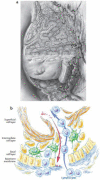Human Papillomavirus and Oropharyngeal Squamous Cell Carcinoma of the Head and Neck: A Growing Epidemic
- PMID: 27132327
- PMCID: PMC5957483
Human Papillomavirus and Oropharyngeal Squamous Cell Carcinoma of the Head and Neck: A Growing Epidemic
Abstract
Human papillomavirus (HPV) is now considered a major causative agent in oropharyngeal squamous cell carcinoma (OP-SCC). The incidence of HPV+ OP-SCC is increasing dramatically, is higher in men, and is now more common than cervical cancer in the United States. HPV+ OPSCCs usually present as locally advanced, stage IV cancers, requiring intensive treatment with surgery, chemotherapy, and/or radiation that can cause tremendous morbidity. HPV vaccination is predicted to prevent HPV+ OP-SCC because over 90% are caused by vaccine-type HPV. However, current vaccination rates are not yet high enough to be effective at preventing HPV-associated malignancies at a population level.
Figures


Similar articles
-
Human papillomavirus in cervical cancer and oropharyngeal cancer: One cause, two diseases.Cancer. 2017 Jun 15;123(12):2219-2229. doi: 10.1002/cncr.30588. Epub 2017 Mar 27. Cancer. 2017. PMID: 28346680 Review.
-
Overview of Advances in Head and Neck Cancer.J Clin Oncol. 2015 Oct 10;33(29):3225-6. doi: 10.1200/JCO.2015.63.6761. Epub 2015 Sep 8. J Clin Oncol. 2015. PMID: 26351331 Review. No abstract available.
-
The New Face of Head and Neck Cancer: The HPV Epidemic.Oncology (Williston Park). 2015 Sep;29(9):616-26. Oncology (Williston Park). 2015. PMID: 26384796 Review.
-
[Human papilloma virus in head and neck cancer].Cancer Radiother. 2014 Oct;18(5-6):430-3. doi: 10.1016/j.canrad.2014.06.003. Epub 2014 Aug 21. Cancer Radiother. 2014. PMID: 25151649 Review. French.
-
Basaloid squamous cell carcinoma of the head and neck: role of HPV and implication in treatment and prognosis.J Clin Pathol. 2010 Oct;63(10):857-66. doi: 10.1136/jcp.2010.078154. J Clin Pathol. 2010. PMID: 20876315 Review.
Cited by
-
Immunotherapy Approaches in HPV-Associated Head and Neck Cancer.Cancers (Basel). 2021 Nov 23;13(23):5889. doi: 10.3390/cancers13235889. Cancers (Basel). 2021. PMID: 34884999 Free PMC article. Review.
-
Genomic Immune Evasion: Diagnostic and Therapeutic Opportunities in Head and Neck Squamous Cell Carcinomas.J Clin Med. 2022 Dec 7;11(24):7259. doi: 10.3390/jcm11247259. J Clin Med. 2022. PMID: 36555876 Free PMC article. Review.
References
-
- Siegel R, Ma J, Zou Z, et al. Cancer statistics, 2014. CA Cancer J Clin. 2014;64:9–29. - PubMed
-
- Centers for Disease Control and Prevention [January 31, 2014];The HPV-Associated Cancers page. Available at: http://www.cdc.gov/cancer/hpv/basic_info/cancers.htm.
-
- Gillison ML, Castellsague X, Chaturvedi A, et al. Eurogin Roadmap: comparative epidemiology of HPV infection and associated cancers of the head and neck and cervix. Int J Cancer. 2014;134:497–507. - PubMed
-
- Gillison ML, D'Souza G, Westra W, et al. Distinct risk factor profiles for human papillomavirus type 16-positive and human papillomavirus type 16-negative head and neck cancers. J Natl Cancer Inst. 2008;100:407–20. - PubMed
MeSH terms
Substances
Grants and funding
LinkOut - more resources
Full Text Sources
Medical
Research Materials
Miscellaneous
